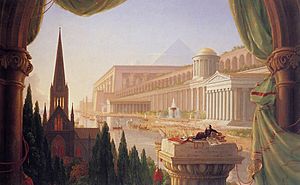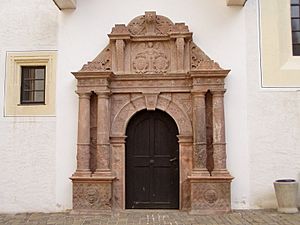Architectural style facts for kids
An architectural style is a special look or design that makes a building or structure unique. It's like a fashion trend for buildings! Each style has its own features, like its shape, how it's built, the materials used, and even local touches.
Most buildings fit into a timeline of styles that change over time. These changes happen because of new ideas, beliefs, religions, or amazing new technologies and materials. For example, new ways to build with steel or concrete led to completely new styles.
Styles often spread from one place to another. For instance, Renaissance ideas started in Italy around 1425. Over the next 200 years, they traveled across Europe. Countries like France, Germany, and England adopted the style, but they added their own unique touches. Styles can also spread through colonialism, where people from one country build in their style in a new land. The Spanish missions in California are a good example, built by Spanish priests in a unique style.
Sometimes, an old architectural style becomes popular again. This is called a "revival." For example, classical styles have been brought back many times, leading to neoclassicism. Each time an old style is revived, it gets a fresh, new look. The Spanish mission style, for instance, was revived 100 years later as the Mission Revival.
Vernacular architecture is a bit different. It refers to everyday buildings made by local people using local materials and traditions. It's more about a way of building that fits the culture and place, rather than a specific "style" with strict rules.
What is Mannerism?
While many architectural styles aim for perfect balance, Mannerism likes to be a bit more dramatic and exaggerated. It's known for being clever and sometimes a bit "unnatural" compared to styles that try to look very realistic. Mannerism often creates buildings that feel a bit tense or unbalanced, rather than calm and clear.
One famous example of Mannerist architecture is the Villa Farnese near Rome. During the 1500s, new printing methods helped Mannerist styles spread quickly. Antwerp was a big center for Mannerist design. From Antwerp, these styles traveled to England, Germany, and other parts of northern and eastern Europe.
In Mannerist buildings, architects played with shapes and spaces. They moved away from the perfect harmony of the Renaissance. The famous artist Michelangelo (1475–1564) is linked to the Mannerist style. He invented the "giant order," which is a huge column-like decoration that goes from the bottom to the top of a building's front. He used this in his design for the Campidoglio in Rome.
For a long time, the word "Mannerism" had a negative meaning, suggesting something was too artificial. But today, it's just used to describe this interesting historical period in art and architecture.
See also
 In Spanish: Estilo arquitectónico para niños
In Spanish: Estilo arquitectónico para niños
- Historicism (architecture)
- History of architecture
- List of architectural styles
- Revivalism (architecture)




